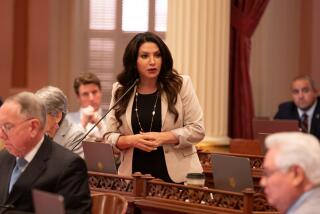New Guidelines Are Proposed for Treating Spouse Abusers
- Share via
The San Diego County Task Force on Domestic Violence has unanimously endorsed a proposal to revamp guidelines governing the rehabilitation of spouse abusers.
The plan is intended to create a more uniform procedure to replace what many consider today’s unwieldy system. Under that system, accused spouse-abusers referred by the courts may be subject to greatly varying treatment. Apart from consistency, supporters say the revised guidelines should help in moderating the behavior of abusers, thus reducing violence.
“What we have has been a bit inconsistent and not as efficient as it could be,” said Ashley Walker-Hooper, co-chairwoman of the task force, who noted that the county has not had a uniform method of treating domestic abusers.
In a major proposed change, the task force would extend treatment for some convicted abusers to a full year, contrasted with the 10-week sessions that are now common, officials said.
The blueprint is preliminary and still requires the approval of county agencies, including the probation department, and some opposition is expected, authorities said. The plan is expected to be forwarded to the probation department within 10 days.
It is hoped that the proposed changes will improve the rehabilitation of spouse-abusers referred from the courts. However, authorities noted that the revisions would do nothing to stem the even larger number of abuse cases that go without prosecution. Most victims do not follow through on legal action against their spouses, authorities say.
Of the more than 17,000 reported cases of domestic violence in the city of San Diego last year, only 2,500 were prosecuted, said Casey Gwinn, co-chairman of the task force and the supervisor of the domestic violence unit of the San Diego city attorney’s office.
“We have a long way to go,” before the problem is solved, Gwinn said.
About 98% of spouse-abusers are men, authorities say.
The new procedures urged by the task force detail specific methods that therapists and counselors can use in treating those who have a history of battering their spouses, said Gwinn, who is with the city attorney’s office. If the task force proposal is adopted, agencies wishing to receive referrals from the county probation department would be obliged to use treatment methods specified in the new guidelines.
Now, authorities say, counselors, therapists and clinical psychologists routinely conduct one-on-one therapy sessions with the abusers. The new protocol will replace the one-on-one treatment with group therapy meetings involving no more than 12 participants per group, Gwinn said. The treatment will last for a year, contrasted with the 10-week life of most treatment programs now in use, Gwinn said.
“You just can’t look at a problem for a month and expect the problem to go away,” Gwinn said. “This is very state of the art. The group process is the only thing that works.”
The therapy is designed to assist abusers in controlling their anger and managing their stress. Counselors also attempt to help abusers understand the roots of their the problem.
Spouse-abusers come from broad range of socioeconomic backgrounds. Authorities say the majority--about 85%--saw violence at home during their childhoods. “They learned it as kids,” Gwinn said. “What they learned during their whole life is going to take at least a year to change.”
Authorities do expect that some officials, counselors and others now involved in the treatment may be reluctant to alter their technique.
More to Read
Sign up for Essential California
The most important California stories and recommendations in your inbox every morning.
You may occasionally receive promotional content from the Los Angeles Times.










